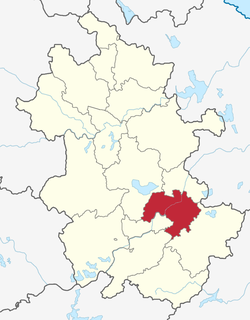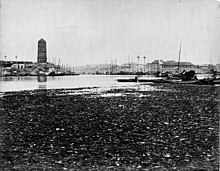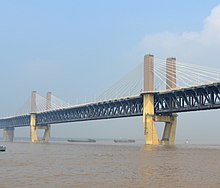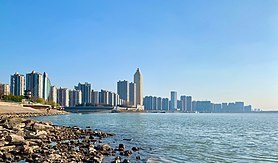Wuhu
This articleneeds additional citations forverification.(July 2012) |
Wuhu
Vu hồ thị | |
|---|---|
Clockwise from top:Wuhu skyline looking south along the Yangtze, Wuhu at sunset, the Zhongjiang Tower, and Changhong Gate (south). | |
 Location of Wuhu in Anhui | |
| Coordinates (Wuhu municipal government):31°21′09″N118°25′59″E/ 31.3526°N 118.4331°E | |
| Country | People's Republic of China |
| Province | Anhui |
| County-level divisions | 8 |
| Municipal seat | Jiujiang District |
| Government | |
| •Party Secretary | Pan Zhaohui(Phan triều huy) |
| • Mayor | He Maoxie(Hạ mậu tiếp) |
| Area | |
| •Prefecture-level city | 6,010.9 km2(2,320.8 sq mi) |
| • Urban | 2,157 km2(833 sq mi) |
| • Metro | 1,172.9 km2(452.9 sq mi) |
| Elevation | 7.9 m (26 ft) |
| Population (2020 census)[1] | |
| •Prefecture-level city | 3,644,420 |
| • Density | 610/km2(1,600/sq mi) |
| •Urban | 2,151,368 |
| • Urban density | 1,000/km2(2,600/sq mi) |
| •Metro | 1,622,799 |
| • Metro density | 1,400/km2(3,600/sq mi) |
| GDP[2] | |
| •Prefecture-level city | CN¥430.3 billion US$53.8 billion |
| • Per capita | CN¥ 117,174 US$ 18,163 |
| Time zone | UTC+8(CST) |
| Area code | 0553 |
| ISO 3166 code | CN-AH-02 |
| License PlatePrefix | Hoàn B |
| Website | www |
Wuhu(simplified Chinese:Vu hồ;traditional Chinese:Vu hồ;pinyin:Wúhú;lit.'Weedy Lake') is aprefecture-level cityin southeasternAnhuiprovince,China. Sitting on the southeast bank of theYangtze River,Wuhu bordersXuanchengto the southeast,ChizhouandTonglingto the southwest,Hefei Cityto the northwest,Ma'anshancity to the northeast,Jiangsuto the east, and is approximately 90 km (56 mi) southwest ofNanjing.With the urbanization trend in the southern part of Nanjing, a conurbation between Nanjing, Maanshan and Wuhu is in building with more than 10,660,000 inhabitants.
History[edit]

Wuhu is known to have been inhabited since at least 570 BCE.[3]Present-day Wuhu evolved out of a settlement known as Jiuzi (Chinese:Cưu tư;pinyin:Jiūzī), located on the southern bank of theShuiyang River,about 20 kilometres (12 mi) southeast of Wuhu's contemporaryurban core.[3]Jiuzi was a site of conflict prior to 670 BCE between theChuand theWuduring theSpring and Autumn period.[3]In 473 BCE, theYuetook Jiuzi from the Wu.[3]In 306 BCE, the Chu took Jiuzi from the Yue.[3]
During the time of the Qin dynasty, Jiuzi was placed under the jurisdiction of the Zhang Commandery (Chinese:Chướng quận;pinyin:Zhāng Jùn).[3]In 109 BCE, Zhang Commandery was renamed toDanyang Commandery.[3]During this time, the area of Juizi was reorganized as Wuhu County (simplified Chinese:Vu hồ huyện;traditional Chinese:Vu hồ huyện;pinyin:Wúhú Xiàn).[3]In 223 CE, under the reign ofSun Quanof theEastern Wu,the county seat was moved from the site of Jiuzi to the highlands along the north banks of theQingyi River,to the southeast of contemporary Wuhu's urban core.[3]
Xuancheng Commanderywas carved-out of Danyang Commandery in 281 CE, with the headquarters of Danyang Commandery moved toNanjing.[3]The area of contemporary Wuhu remained under the jurisdiction of Danyang Commandery.[3]During theEastern Jinperiod, the area saw an influx of people migrate to the area from theCentral Plains.[3]The area was placed under the jurisdiction of Xuancheng Commandery in 363 CE, and thecommandery'sheadquarters were moved to the area.[3]During the late 4th Century, the area underwent a number of other administrative changes.[3]Part of the area would fall under the jurisdiction ofHuainan Commandery.[3]
Both Xuancheng Commandery and Huainan Commandery were abolished early on during theSui dynasty,in 589 CE.[3]
In 627 CE, under theTang dynasty,the area was re-organized as Xuan Prefecture (Chinese:Tuyên châu;pinyin:Xuān Zhōu), and placed under the jurisdiction ofJiangnan Circuit.[3]In 733 CE, it became part of the newly-createdJiangnanxi Circuit.[3]In 758 CE, it was transferred to be part ofSheng Prefecture,inJiangnandong Circuit.[3]Three years later, it would return to Xuan Prefecture in Jiangnanxi Circuit.[3]In 787 CE, Xuan Prefecture was transferred to Jiangnandong Circuit.[3]
In 937 CE, upon the creation of theSouthern Tangduring theFive Dynasties and Ten Kingdoms period,Wuhu County was established, and placed underJiangning Fu.[3]Since then, Wuhu went uninterrupted as an administrative unit throughout the remainder of dynastic China.[3]
During theSong dynasty,Wuhu County belonged to Jiangnan Circuit, and later Jiangnandong Circuit.[3]
In 1277, during theYuan dynasty,Wuhu County was placed under the jurisdiction ofTaiping Circuit.[3]In 1355, Taiping Circuit was replaced byTaiping Fu,and Wuhu County was placed under its jurisdiction.[3]
Taiping Fu was under the jurisdiction ofZhongshu Shenguntil its abolition in 1380, during theMing dynasty.[3]Throughout the Ming dynasty, Wuhu County remained under the jurisdiction of Taiping Fu.[3]Under the Ming dynasty, Wuhu developed into a major commercial center and river port and since that time has been known as a center of the rice trade.[citation needed]
In 1644, theHongguang Emperor(better known as thePrince of Fu), one of the last emperors of the Ming dynasty, was captured by forces of the newQing dynastyin Wuhu County.[citation needed]During theTaiping Rebellion,Wuhu County exchanged hands more than five times between Taiping and Imperial forces.[citation needed]Wuhu County was placed under the jurisdiction ofHuiningchitaiguang Circuitduring the Taiping Rebellion.[3]The city became atreaty portin 1876 and has remained a commercial center since that time.[citation needed]The city'sRoman Catholiccathedral,St. Joseph's Cathedral(Thánh nhược sắt chủ giáo tọa đường), dates from this time. Most of the downtown area alongside the Yangtze River was ceded in the British concession.[citation needed]
Upon the establishment of theRepublic of Chinain 1912, Fu, Prefectures, and Ting were established, and counties were placed under direct provincial jurisdiction.[3]Wuhu County was directly governed by Anhui province from 1912 until 1914, whenWuhu Circuitwas established to govern 23 counties in the area, including Wuhu County, until 1928.[3]Trade in rice, wood, and tea flourished at Wuhu until theWarlord Eraof the 1920s and 1930s, whenbanditswere active in the area.[citation needed]In 1932, Wuhu County was placed under the jurisdiction of the Second Administrative Division of Anhui province (Chinese:An huy tỉnh đệ nhị chuyên khu;pinyin:Ānhuī Shěng Dì Èr Zhuānqū).[3]


At the beginning of theSecond Sino-Japanese War,part of theSecond World War,Wuhu was occupied by Japan on December 10, 1937.[citation needed]This was a prelude to theBattle of Nanjing,ending in theNanjing massacre.[citation needed]Under Japanese occupation, Chinese resistance fighters hid in the lakes around Wuhu by submerging themselves and breathing through reeds.[citation needed]In early 1938, Japan moved Wuhu County from the Second Administrative Division to the Fifth Administrative Division.[3]On October 25, 1938, they transferred Wuhu County to the Ninth Administrative Division.[3]Japan had again changed the region's divisions in August 1941, and placed Wuhu County under the Sixth Administrative Division.[3]
Japanese forces had been expelled from the area by August 1945, and Kuomintang forces placed Wuhu County under theSouthern Anhui Administrative Office,and remained part of the Sixth Administrative Division.[3]
ThePeople's Liberation Armycaptured Wuhu on April 24, 1949.[3]Three days later, it was placed under the jurisdiction of a local military committee.[3]ThecivilianWuhu Municipal People's Government was established on May 10, 1949.[3]Two days later, a civilian government was formed for Wuhu County, which was placed under the jurisdiction of Wuhu.[3]
From December 1, 1967, to April 1, 1968, during the tumult of theCultural Revolution,Wuhu was placed undermilitary rule.[3]
Major industries began to be developed in Wuhu after the Second World War, with the development of the textile industry, shipbuilding, and paper mills.[citation needed]Despite this, Wuhu had been lagging behindMa'anshanandTonglingin industrial production for decades after theestablishment of the People's Republic of Chinaand remained primarily a commercial center for trade in rice, silk, cotton, tea, wheat and eggs.[citation needed]However, with recent years' economic rise, Wuhu has become a hub for manufacturing.[citation needed]
In July 2016, the area was afflicted by the2016 China floods.[4]
On July 6, 2020, the Anhui provincial government approved the merger ofSanshan DistrictintoYijiang District,the replacement of Wuhu County withWanzhi District,and the replacement of Fanchang County withFanchang District.[3]
In June 2023, the area was afflicted by flooding.[5]
Administration[edit]
Theprefecture-level cityof Wuhu administers 8county-level divisions,including 5districts,1county,and 1county-level city.[6]
| Name | Simplified Chinese | Pinyin | Population | Postal Code |
|---|---|---|---|---|
| Jinghu District | Kính hồ khu | Jìnghú Qū | 478,658 | 241000 |
| Yijiang District | Dặc giang khu | Yìjiāng Qū | 422,620 | 241002 |
| Jiujiang District | Cưu giang khu | Jiūjiāng Qū | 721,521 | 241000 |
| Wanzhi District | Loan chỉ khu | Wānzhǐ Qū | 344,016 | 241100 |
| Fanchang District | Phồn xương khu | Fánchāng Qū | 243,907 | 241200 |
| Nanling County | Nam lăng huyện | Nánlíng Xiàn | 431,148 | 241300 |
| Wuweicity | Vô vi thị | Wúwéi Shì | 817,997 | 238300 |
| Map |
|---|
- Defunct –Sanshan District
Climate[edit]
| Climate data for Wuhu (1991–2020 normals, extremes 1981–2010) | |||||||||||||
|---|---|---|---|---|---|---|---|---|---|---|---|---|---|
| Month | Jan | Feb | Mar | Apr | May | Jun | Jul | Aug | Sep | Oct | Nov | Dec | Year |
| Record high °C (°F) | 21.1 (70.0) |
29.4 (84.9) |
30.7 (87.3) |
34.4 (93.9) |
35.9 (96.6) |
38.2 (100.8) |
40.1 (104.2) |
41.0 (105.8) |
38.6 (101.5) |
33.2 (91.8) |
29.2 (84.6) |
22.6 (72.7) |
41.0 (105.8) |
| Mean daily maximum °C (°F) | 7.7 (45.9) |
10.5 (50.9) |
15.5 (59.9) |
21.9 (71.4) |
27.1 (80.8) |
29.6 (85.3) |
33.1 (91.6) |
32.6 (90.7) |
28.4 (83.1) |
23.1 (73.6) |
16.9 (62.4) |
10.3 (50.5) |
21.4 (70.5) |
| Daily mean °C (°F) | 3.9 (39.0) |
6.3 (43.3) |
10.8 (51.4) |
17.0 (62.6) |
22.3 (72.1) |
25.6 (78.1) |
29.2 (84.6) |
28.6 (83.5) |
24.2 (75.6) |
18.6 (65.5) |
12.3 (54.1) |
6.1 (43.0) |
17.1 (62.7) |
| Mean daily minimum °C (°F) | 1.0 (33.8) |
3.1 (37.6) |
7.2 (45.0) |
12.8 (55.0) |
18.2 (64.8) |
22.3 (72.1) |
26.0 (78.8) |
25.5 (77.9) |
21.1 (70.0) |
15.1 (59.2) |
8.8 (47.8) |
3.0 (37.4) |
13.7 (56.6) |
| Record low °C (°F) | −7.8 (18.0) |
−8.1 (17.4) |
−3.2 (26.2) |
2.7 (36.9) |
9.6 (49.3) |
13.4 (56.1) |
19.4 (66.9) |
17.4 (63.3) |
13.1 (55.6) |
3.8 (38.8) |
−3.1 (26.4) |
−8.5 (16.7) |
−8.5 (16.7) |
| Averageprecipitationmm (inches) | 65.6 (2.58) |
70.6 (2.78) |
101.9 (4.01) |
100.4 (3.95) |
113.7 (4.48) |
209.6 (8.25) |
185.3 (7.30) |
144.1 (5.67) |
80.1 (3.15) |
56.1 (2.21) |
59.4 (2.34) |
43.2 (1.70) |
1,230 (48.42) |
| Average precipitation days(≥ 0.1 mm) | 10.8 | 10.5 | 12.4 | 11.2 | 11.5 | 12.3 | 11.6 | 11.5 | 8.3 | 8.1 | 9.0 | 7.9 | 125.1 |
| Average snowy days | 3.9 | 2.1 | 0.7 | 0.1 | 0 | 0 | 0 | 0 | 0 | 0 | 0.4 | 1.0 | 8.2 |
| Averagerelative humidity(%) | 77 | 75 | 74 | 72 | 72 | 78 | 78 | 79 | 78 | 76 | 77 | 75 | 76 |
| Mean monthlysunshine hours | 106.0 | 110.8 | 138.1 | 165.2 | 177.8 | 149.5 | 198.7 | 191.5 | 151.8 | 156.6 | 135.6 | 124.9 | 1,806.5 |
| Percentpossible sunshine | 33 | 35 | 37 | 42 | 42 | 35 | 46 | 47 | 41 | 45 | 43 | 40 | 41 |
| Source:China Meteorological Administration[7][8] | |||||||||||||
Demographics[edit]
| Year | Pop. | ±% |
|---|---|---|
| 1953 | 242,143 | — |
| 1964 | 333,465 | +37.7% |
| 1982 | 456,219 | +36.8% |
| 1990 | 441,999 | −3.1% |
| 2000 | 641,259 | +45.1% |
| 2010 | 1,108,087 | +72.8% |
| 2020 | 1,598,165 | +44.2% |
| Source:Census in China[9] | ||
Population[edit]
As of the2020 Chinese census,Wuhu had a total population of 3,644,420 inhabitants whom 1,622,799 lived its built-up (or metro) area made ofJiujiang District,Jinghu DistrictandYijiang District.As of 2022, 13.75% of Wuhu's population is 14 years old or younger, 65.60% is 15 to 59 years old, and 20.65% is 60 years old or older.[10]16.89% of Wuhu's population is 65 years or older.[10]
The city is home to 47 recognizedethnic minorities,the largest of which are the Hui, Miao, and Zhuang.[11]Other ethnic minorities with over 500 inhabitants in the city include theYi,theTujia,theMiao,theZhuang,and theManchu.[citation needed]
Language[edit]
Wuhu dialect,a variety ofJiang-Huai Mandarin,itself a branch ofMandarin Chinese,is commonly spoken in urban areas.[11]Putonghua,orStandard Mandarin,was commonly used in this area.[citation needed][clarification needed]In some areas, Wu Chinese is spoken instead.[11]
Economy[edit]
The city is the second largest economy inAnhui,afterHefei,the provincial capital.[citation needed]Like elsewhere in China, Wuhu was seen rapid economic growth in the 21st Century, with its GDP nearly doubling from 2014 to 2022 alone,[12]and its GDP per capita nearly doubling from 2012 to 2019 alone.[13]
As of 2022, Wuhu has a gross domestic product (GDP) of 450.213 billionrenminbi(RMB).[10][12]Per 2022 data, the city'sprimary sectorof the economy accounts for 17.925 billion RMB of the city's GDP (3.98% of total GDP), thesecondary sectoraccounts for 213.558 billion RMB (47.43%), and thetertiary sectoraccounts for 218.730 billion RMB (48.58%).[10]
As of 2019, Wuhu's GDP per capita was 96,154 RMB.[13]The city's statistics bureau reported an annual per capitadisposable incomeof 43,145 RMB in 2022 (+6.5% from 2021).[10]The city's urban residents have a per capita disposable income of 51,481, while this stands at 29,518 among rural residents.[10]
In 2022, Wuhuexported9.468 billionUnited States dollars(USD) worth of goods and services, andimported4.142 billion USD worth of goods and services.[10]
Major industrial products in Wuhu includeautomobiles,HVACunits,plate glass,cement, steel, and copper.[10]
Wuhu Economic & Technological Development Area in the north of the city launched in 1993 is one of the first state-level economic and technological development area in Anhui province.[citation needed]It has the only export processing zone in the province.[14][page needed]Chery AutomobileandAnhui Conch Cement Companyare headquartered in this development area.[15][16]
Wuhu is the fifth largest port alongsideYangtze River.[citation needed]Yuxikou Pier is the largest inland river coal harbor in China.[citation needed]
Transportation[edit]
Bus and taxi[edit]
The city is served by Wuhu Bus (Chinese:Vu hồ công giao;pinyin:Wúhú Gōngjiāo), amunicipalbus services and taxi services provider.[17]Wuhu Bus runs 157 different routes, serviced by more than 1,300 vehicles.[17]About 200,000 passengers use the service daily.[17]
Airport[edit]
The city is served by theWuhu Xuanzhou Airportwhich opened on April 30, 2021.
Bridge[edit]

Wuhu has oneYangtze River crossing—theWuhu Yangtze River Bridge,opened in 2000, carries theG5011 Wuhu–Hefei Expresswayand Huainan Railway.[citation needed]
Train[edit]
Wuhu is served by theAnhui–Jiangxi,Nanjing–TonglingandHuainan Railways.[citation needed]It only takes 2.5 hoursfrom Shanghai to Wuhu by high-speed train.[citation needed]
Monorail system[edit]
Wuhu Rail Transit consists of two lines (Lines 1 and 2) which opened on November 3 and December 28, 2021.[18][19]
Culture[edit]
The acclaimed poetLi Baispent his late life in Wuhu, it is said, due to its striking landscape. Li Bai was born inSuyab,an ancientSilk Roadcity in Central Asian, and raised in southwestern China.Xie Tiao,one of the most distinctiveSix Dynastypoets whom he greatly admired, left many poems when holding positions here.
During theTang dynasty(619–907), the poetDu Muwrote a famous poemThoughts on Staying Again at Wuhu.
A factory in Wuhu carries on the local craft of makingwrought ironpictures. Other local handicrafts are embossedlacquerwareand ricestraw pith patchwork.A famous stone tablet in Wuhu recording local events of theSong dynastyperiod (ca. 1000 AD) is considered to be a masterpiece of the renowned calligrapherMi Fu.
Folklore[edit]
An itinerant blacksmith namedTang Tianchiis reputed to have invented the wrought-iron picture in Wuhu, when a painter whom he admired chided him, "You will never make pictures by beating iron."
Another blacksmith of theSpring and Autumn period(770–476 BC) namedGan Jiangwas famous for sword making. Zhe Shan (Reddish Brown Hill) is said to get its colour from the flames of Gan Jiang's furnace.Shen Shan(Sacred Hill) is the legendary location of his sword grinding rock and tempering pool.
Cuisine[edit]
Wuhu andAnqingare noted centers of theYanjiang cuisine.It specializes in freshwater fish and poultry, and features special techniques of chopping, shaping, and colouring. The flavour of Yanjiang dishes is often enhanced by sweetening and smoking.
Religion/Medicine[edit]
The New York Methodist Mission Society's SuperintendentVirgil C. Hartarrived in Wuhu in 1881, intent on purchasing a piece of property to build the city's first Methodist Church and Western-style hospital. Hart was able to secure theYichisan Hillbefore the British, who wanted the property to build a consulate and naval base[citation needed].TheYichisan Hospitalis Anhui's oldest/continuous western hospital.Dr. Edgerton H. Hart(V.C. Hart's eldest son) became the hospital's Director in 1895 and continued at that capacity until his death in April 1913.[20]Caroline Maddockarrived in Wuhu in October 1904, to serve as the General Hospital's Head Nurse. Caroline Maddock married Dr. Edgerton Hart in October 1907. In 1909, Caroline and four other nurses founded the Nurses Association of China and she served as its first president; this association still represents China's Nurse profession.[21][22]
Heritage and Tourism[edit]
Several sites in Wuhu have been included on theChina's List of Major National Historical and Cultural Sites.They include theGuangji Temple(Quảng tế tự), a Buddhist temple originally dating back to the Tang dynasty that contains the Zhe pagoda, an edifice from theNorthern Song dynasty.

Other listed monuments date back to the 19th century, when Wuhu was a British treaty port. These includeSt. Joseph Cathedral,the site of the former British Consulate, the former Customs Building on the Yangtze River and the site of the former St. James Secondary School.[23]
Other touristic sites in Wuhu:
- Mirror Lake(Kính hồ)
- Jiuzi Plaza(Cưu tư quảng tràng)
- Yangtze Riverside Park(Tân giang công viên)
- Mount Zhe,a hill park (Giả sơn)
- Fantawild Adventure,one of the largest theme parks in the Chinese Mainland (Phương đặc nhạc viên - tứ tọa)
- Sculpture Park (Điêu tố công viên)
- Longwo Lake (Long oa hồ)
- Phoenix Cuisine Boulevard(Phượng hoàng mỹ thực nhai)
- Maren Qifeng Scenic Area (Mã nhân kỳ phong phong cảnh khu)
- Jiuzi Old Town (Cưu tư cổ trấn)
- Macrolink Beluga Ocean Park (Tân hoa liên đại bạch kình hải dương công viên)
- Wuhu Olympic Stadium(Áo lâm thất khắc thể dục quán)
- Yangtze River Bridge Crossing(Trường giang đại kiều)
Education[edit]
- Universities and Colleges
- Anhui Normal University
- Anhui Polytechnic University
- Wannan Medical College
- Wuhu Radio and TV University(Vu hồ quảng bá điện thị đại học)
- Wuhu Institute of Technology(Vu hồ chức nghiệp kỹ thuật học viện)
- Anhui Business College of Vocational Technology(An huy thương mậu chức nghiệp kỹ thuật học viện)
- Anhui Technical College of Mechanical and Electrical Engineering(An huy cơ điện chức nghiệp kỹ thuật học viện)
- Anhui college of Chinese traditional medicine(An huy trung y dược cao đẳng chuyên khoa học giáo)
- Anhui vocational college of information technology(Vu hồ tín tức chức nghiệp học viện)
- High Schools
- Wuhu City No. 1 High School(Vu hồ thị đệ nhất trung học)
- High School Affiliated to Anhui Normal University(An huy sư phạm đại học phụ chúc trung học)
- Wuhu County No. 1 High School(Vu hồ huyện đệ nhất trung học)
- Wuhu City No. 12 High School(Vu hồ thị đệ thập nhị trung học)
- Fanchang County No. 1 High School(Phồn xương huyện đệ nhất trung học)
Health care system[edit]
- Notable hospitals[citation needed]
- Yijishan Hospital(Dặc cơ sơn y viện,or Affiliated Hospital of Wannan Medical College (Hoàn nam y học viện phụ chúc dặc cơ sơn y viện)
- Xuancheng Area Hospital (Tuyên thành địa khu nhân dân y viện), or Second Affiliated Hospital of Wannan Medical College (Hoàn nam y học viện đệ nhị phụ chúc y viện)
- Wuhu Second Hospital (Vu hồ thị đệ nhị nhân dân y viện)
- Wuhu First Hospital (Vu hồ thị đệ nhất nhân dân y viện)
- Wuhu Third Hospital (Vu hồ thị đệ tam nhân dân y viện)
- Wuhu Fourth Hospital (Vu hồ thị đệ tứ nhân dân y viện)
- Wuhu Fifth Hospital (Vu hồ thị đệ ngũ nhân dân y viện)
- Wuhu Hospital of Traditional Chinese Medicine (Vu hồ thị trung y viện)
- Maternal and Child Health Hospital of Wuhu City (Vu hồ thị phụ ấu bảo kiện viện)
- Wuhu Red Cross Hospital (Vu hồ thị hồng thập tự y viện)
- Related health care settings
- Wuhu CDC (Vu hồ thị tật bệnh dự phòng khống chế trung tâm)
- Wuhu Center of Blood (Vu hồ thị trung tâm huyết trạm)
Notable people[edit]
- Xiao Yuncong(1596–1673),Ming Dynastypainter
- Zhao Wei(born 1976), actress
- Zhou Lüxin(born 1988), diver
- Wang Ying,(1913–1974) actress and author
- Jackie Chan(born 1954), actor and martial artist (father from Wuhu)
- Chen Duxiu(Chinese:Trần độc tú;Wade–Giles:Ch'en Tu-hsiu;October 8, 1879 – May 27, 1942) was a Chinese revolutionary socialist, educator, philosopher and author, who co-founded the Chinese Communist Party (with Li Dazhao) in 1921, serving from 1921 to 1927 as its first General Secretary. (teacher of Wanjiang school.)
- Wang Chuanfu(born 1966), billionaire, founder and CEO ofBYD Company.
Notable constructions[edit]
- 229 metres (751 ft) tall pylons ofHVDC Yangtze River Crossing Wuhu,a part ofHVDC Three Gorges-Changzhou,are the tallest pylons used forHVDC.
In popular culture[edit]
Nintendo added Wuhu Island to Wii Sports Resort.
Sister cities and friendly cities[edit]
 Kōchi,Kōchi Prefecture,Japan
Kōchi,Kōchi Prefecture,Japan Pavia,Lombardy, Italy
Pavia,Lombardy, Italy Torrejón de Ardoz,Madrid, Spain
Torrejón de Ardoz,Madrid, Spain West Covina, California,United States
West Covina, California,United States
References[edit]
- ^"China: Ānhuī (Prefectures, Cities, Districts and Counties) – Population Statistics, Charts and Map".
- ^"《 an huy thống kế niên giám 2022》 điện tử tra duyệt bản".tjj.ah.gov.cn.Archivedfrom the original on October 18, 2022.RetrievedOctober 18,2022.
- ^abcdefghijklmnopqrstuvwxyzaaabacadaeafagahaiajakalamanaoapLịch sử duyên cách[Organizational history].www.wuhu.gov.cn(in Chinese). Wuhu Municipal People's Government. January 5, 2023.Archivedfrom the original on June 11, 2023.RetrievedJune 11,2023.
- ^"China flooding: Wuhan on red alert for further rain".BBC News.July 6, 2016.RetrievedJune 11,2023.
- ^"Three die, farmland and trees damaged as storms sweep across China".Reuters.June 11, 2023.RetrievedJune 11,2023.
- ^"Trọng bàng! Quốc vụ viện phê phục đồng ý vu hồ thị bộ phân hành chính khu hoa điều chỉnh - tân hoa võng".csj.xinhuanet.com.Archived fromthe originalon July 6, 2020.RetrievedJuly 6,2020.
- ^Trung quốc khí tượng sổ cư võng – WeatherBk Data(in Simplified Chinese).China Meteorological Administration.RetrievedSeptember 24,2023.
- ^ "Experience Template"Trung quốc khí tượng sổ cư võng(in Simplified Chinese).China Meteorological Administration.RetrievedSeptember 24,2023.
- ^Spatial Data Lab (2020)."China County Map with 2000-201o Population Census Data".dataverse.harvard.edu.doi:10.7910/DVN/VKGEBX.RetrievedJanuary 6,2024.
- ^abcdefgh2022 niên vu hồ thị quốc dân kinh tế hòa xã hội phát triển thống kế công báo[2022 Wuhu Municipal Economic and Social Development Statistical Bulletin] (in Chinese). Wuhu Municipal Statistics Bureau. March 31, 2023.Archivedfrom the original on July 9, 2023.RetrievedJuly 8,2023.
- ^abcHành chính khu hoa[Administrative Divisions].www.wuhu.gov.cn(in Chinese). Wuhu Municipal People's Government. March 29, 2023.Archivedfrom the original on June 12, 2023.RetrievedJuly 8,2023.
- ^ab"GDP: Anhui: Wuhu".www.ceicdata.com.RetrievedJuly 9,2023.
- ^ab"GDP: per Capita: Anhui: Wuhu".www.ceicdata.com.RetrievedJuly 9,2023.
- ^Vu hồ kinh tế kỹ thuật khai phát khu.Weda.gov.cn.RetrievedSeptember 6,2011.
- ^Liên hệ ngã môn[Contact Us].www.chery.cn(in Chinese).Chery.RetrievedJune 11,2023.
- ^Công tư tư liêu[Company Profile].www.conch.cn(in Chinese).Anhui Conch Cement.RetrievedJune 11,2023.
- ^abcQuan vu ngã môn[About Us].www.whsgj.com(in Chinese).Archivedfrom the original on July 9, 2023.RetrievedJuly 8,2023.
- ^"Wuhu driverless monorail line opens".PEOPLEMOVERS & MONORAILS. November 4, 2021.RetrievedJanuary 10,2022.
- ^"The first phase of Wuhu Rail Transit Line 2 opened for operation".Seetao. December 30, 2021.RetrievedJanuary 10,2022.
- ^"Man On A Mission" by Stanley Crawford
- ^"About Yijishan Hospital".First Affiliated Hospital of Wannan Medical College.RetrievedMay 14,2022.
- ^Crawford Green, Cathleen; Crawford, Stanley; Maddock Hart, Caroline (May 1, 2014).Wuhu Missionaries.Eye Soar, Inc. p. 262.ISBN9780991608232.
- ^"Major Historical and Cultural Sites of China – Announcement of Batch 8".Archived fromthe originalon October 16, 2019.
External links[edit]
- Government website of Wuhu(in Chinese, English, and Japanese)
- Wuhu.Me – English Community of City Wuhu, Anhui. China





